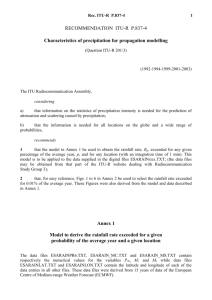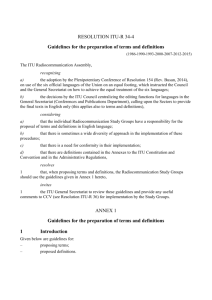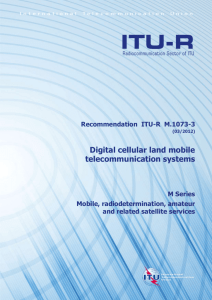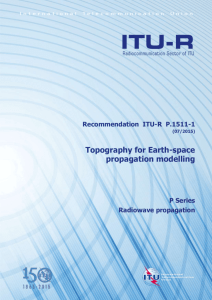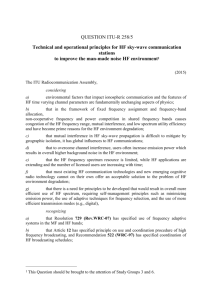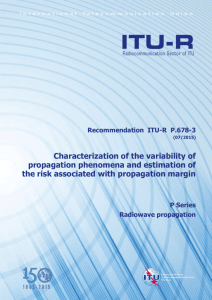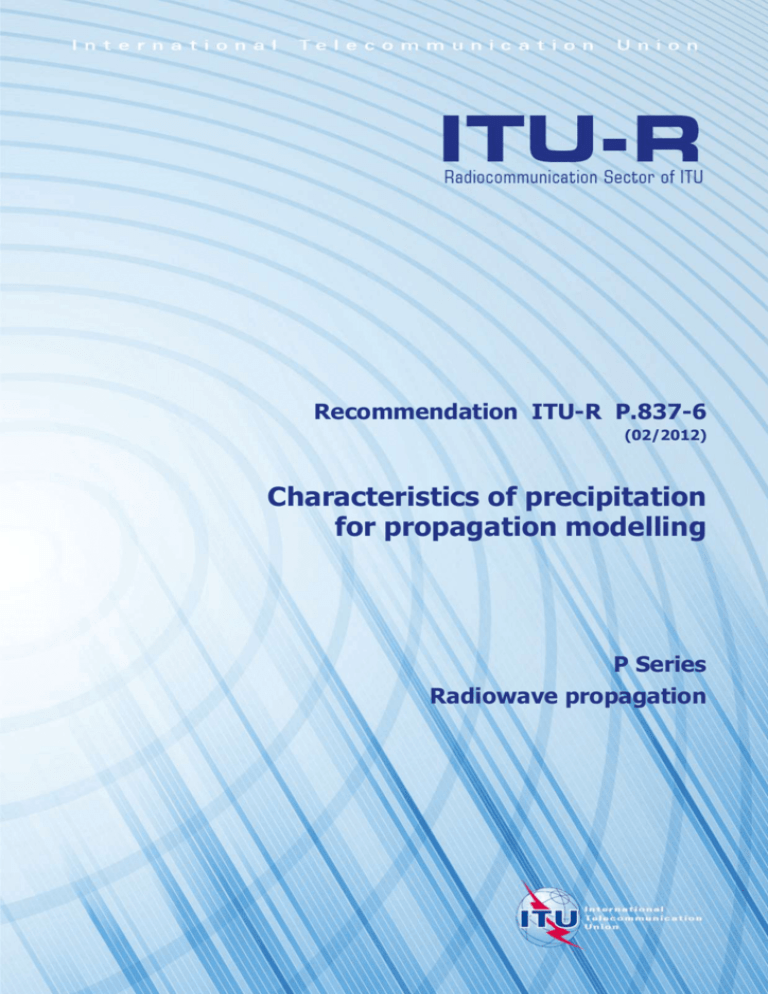
Recommendation ITU-R P.837-6
(02/2012)
Characteristics of precipitation
for propagation modelling
P Series
Radiowave propagation
ii
Rec. ITU-R P.837-6
Foreword
The role of the Radiocommunication Sector is to ensure the rational, equitable, efficient and economical use of the
radio-frequency spectrum by all radiocommunication services, including satellite services, and carry out studies without
limit of frequency range on the basis of which Recommendations are adopted.
The regulatory and policy functions of the Radiocommunication Sector are performed by World and Regional
Radiocommunication Conferences and Radiocommunication Assemblies supported by Study Groups.
Policy on Intellectual Property Right (IPR)
ITU-R policy on IPR is described in the Common Patent Policy for ITU-T/ITU-R/ISO/IEC referenced in Annex 1 of
Resolution ITU-R 1. Forms to be used for the submission of patent statements and licensing declarations by patent
holders are available from http://www.itu.int/ITU-R/go/patents/en where the Guidelines for Implementation of the
Common Patent Policy for ITU-T/ITU-R/ISO/IEC and the ITU-R patent information database can also be found.
Series of ITU-R Recommendations
(Also available online at http://www.itu.int/publ/R-REC/en)
Series
BO
BR
BS
BT
F
M
P
RA
RS
S
SA
SF
SM
SNG
TF
V
Title
Satellite delivery
Recording for production, archival and play-out; film for television
Broadcasting service (sound)
Broadcasting service (television)
Fixed service
Mobile, radiodetermination, amateur and related satellite services
Radiowave propagation
Radio astronomy
Remote sensing systems
Fixed-satellite service
Space applications and meteorology
Frequency sharing and coordination between fixed-satellite and fixed service systems
Spectrum management
Satellite news gathering
Time signals and frequency standards emissions
Vocabulary and related subjects
Note: This ITU-R Recommendation was approved in English under the procedure detailed in Resolution ITU-R 1.
Electronic Publication
Geneva, 2013
ITU 2013
All rights reserved. No part of this publication may be reproduced, by any means whatsoever, without written permission of ITU.
Rec. ITU-R P.837-6
1
RECOMMENDATION ITU-R P.837-6
Characteristics of precipitation for propagation modelling
(Question ITU-R 201/3)
(1992-1994-1999-2001-2003-2007-2012)
Scope
Recommendation ITU-R P.837 contains maps of meteorological parameters that have been obtained
using the European Centre for Medium-Range Weather Forecast (ECMWF) ERA-40 re-analysis
database, which are recommended for the prediction of rainfall rate statistics with a 1-min
integration time, when local measurements are missing.
Rainfall rate statistics with a 1-min integration time are required for the prediction of rain
attenuation in terrestrial and satellite links. Data of long-term measurements of rainfall rate may be
available from local sources, but only with higher integration times. This Recommendation provides
a method for the conversion of rainfall rate statistics with a higher integration time to rainfall rate
statistics with a 1-min integration time.
The ITU Radiocommunication Assembly,
considering
a)
that information on the statistics of precipitation intensity is needed for the prediction of
attenuation and scattering caused by precipitation;
b)
that the information is needed for all locations on the globe and a wide range of
probabilities;
c)
that rainfall rate statistics with a 1-min integration time are required for the prediction of
rain attenuation and scattering in terrestrial and satellite links;
d)
that long-term measurements of rainfall rate may be available from local sources with a
1-min integration time and also, with integration times of longer than 1-min,
e)
that using a model to convert local measurements with integration times up to 1 hour has
been observed to provide higher accuracy than the use of the global digital maps in Annex 1 of this
Recommendation,
recommends
1
that the model in Annex 1 should be used to obtain the rainfall rate, Rp, exceeded for any
given percentage of the average year, p, and for any location (with an integration time of 1 min).
This model is to be applied to the data supplied in the digital files ESARAIN_xxx_v5.TXT (the
data files may be obtained from that part of the ITU-R website dealing with Radiocommunication
Study Group 3);
2
that, for easy reference, Figs 1 to 6 in Annex 2 should be used to select the rainfall rate
exceeded for 0.01% of the average year. These figures were also derived from the model and data
described in Annex 1;
3
that local long-term measurements of rainfall rate with a 1-min integration time should be
used if available;
2
Rec. ITU-R P.837-6
4
that long-term measurements of rainfall rate with longer integration times should be used if
available and the model in Annex 3 be used to convert to rainfall rate with a 1-min integration time;
5
that local measurements, if used, are collected over a sufficient period (typically longer than
3 years), to ensure statistical stability.
Annex 1
Model to derive the rainfall rate exceeded for a given
probability of the average year and a given location
The data files ESARAIN_PR6_v5.TXT, ESARAIN_MT_v5.TXT and ESARAIN_BETA_v5.TXT
contain respectively the numerical values for the variables Pr6, Mt and while data files
ESARAINLAT_v5.TXT and ESARAINLON_v5.TXT contain the latitude and longitude of each of
the data entries in all other files. These data files were derived from 40 years of data from the
European Centre of Medium-range Weather Forecast (ECMWF).
Step 1: Extract the variables Pr6, Mt and for the four points closest in latitude (Lat) and longitude
(Lon) to the geographical coordinates of the desired location. The latitude grid is from 90 N to
–90 S in 1.125° steps; the longitude grid is from 0 to 360 in 1.125 steps.
Step 2: From the values of Pr6, Mt and at the four grid points, obtain the values Pr6(Lat,Lon),
MT(Lat,Lon) and (Lat,Lon) at the desired location by performing a bi-linear interpolation, as
described in Recommendation ITU-R P.1144.
Step 3: Convert MT and to Mc and Ms as follows:
Mc = MT
Ms = (1-) MT
Step 4: Derive the percentage probability of rain in an average year, P0, from:
P0 ( Lat , Lon) Pr 6 ( Lat , Lon) 1 e 0.0079 ( Ms ( Lat , Lon) / Pr 6 ( Lat , Lon )
(1)
If Pr6 is equal to zero, the percentage probability of rain in an average year and the rainfall rate
exceeded for any percentage of an average year are equal to zero. In this case, the following steps
are unnecessary.
Step 5: Derive the rainfall rate, Rp, exceeded for p % of the average year, where p P0, from:
R p ( Lat , Lon)
B B 2 4 AC
2A
mm/h
(2)
where:
Aab
(2a)
B a c ln( p / P0(Lat,Lon))
(2b)
C ln( p / P0(Lat,Lon))
(2c)
Rec. ITU-R P.837-6
3
and
a 1.09
b
( Mc ( Lat , Lon) Ms ( Lat , Lon))
21797 P0
c 26.02b
(2d)
(2e)
(2f)
NOTE 1 – An implementation of this model and the associated data in MATLAB is also available from
the ITU-R website dealing with Radiocommunication Study Group 3.
Latitude (degrees)
–90
–180 –160
–80
–70
–60
–50
–40
–30
–20
–10
0
10
20
30
40
50
60
70
80
90
–140
–120 –100
–80
–60
–40
0
20
Longitude (degrees)
–20
40
60
80
100
120
140
160
P.0837-01
180
4
Rec. ITU-R P.837-6
Annex 2
FIGURE 1
Rain rate (mm/h) exceeded for 0.01% of the average year
Rec. ITU-R P.837-6
5
FIGURE 2
10
–180
20
30
40
60
70
80
50
Latitude (degrees)
90
–160
–140
–120
Longitude (degrees)
–100
–80
–60
–40
P.0837-02
Rain rate (mm/k) exceeded for 0.01% of the average year
6
Rec. ITU-R P.837-6
FIGURE 3
Rain rate (mm/h) exceeded for 0.01% of the average year
10
0
Latitude (degrees)
–10
–20
–30
–40
–50
–60
–80
–60
–40
Longitude (degrees)
P.0837-03
Rec. ITU-R P.837-6
7
FIGURE 4
40
50
60
Latitude (degrees)
70
–20
0
Longitude (degrees)
20
40
P.0837-04
Rain rate (mm/h) exceeded for 0.01% of the average year
8
Rec. ITU-R P.837-6
FIGURE 5
Rain rate (mm/h) exceeded for 0.01% of the average year
40
30
20
Latitude (degrees)
10
0
–10
–20
–30
–40
–20
0
20
40
60
Longitude (degrees)
P.0837-05
Rec. ITU-R P.837-6
9
FIGURE 6
0
10
20
30
40
60
70
80
50
Latitude (degrees)
90
60
80
Longitude (degrees)
100
120
140
160
P.0837-06
180
Rain rate (mm/h) exceeded for 0.01% of the average year
10
Rec. ITU-R P.837-6
FIGURE 7
Rain rate (mm/h) exceeded for 0.01% of the average year
60
50
Latitude (degrees)
40
30
20
10
0
–10
80
100
120
140
Longitude (degrees)
P.0837-07
Rec. ITU-R P.837-6
11
FIGURE 8
Rain rate (mm/h) exceeded for 0.01% of the average year
20
10
0
Latitude (degrees)
–10
–20
–30
–40
–50
–60
100
120
140
160
180
Longitude (degrees)
P.0837-08
Annex 3
1
The cumulative distribution of rainfall rate at 1-min integration time can be obtained by
converting local cumulative distributions measured at integration times of between 5 and
60 minutes.
2
The recommended method requires as input both the cumulative distribution as well as the
integration time of the source rainfall statistics and the geographical coordinates of the site of
interest.
3
The method is based on the simulated movement of synthetic rain cells, whose parameters
derive from the local input data and ECMWF products.
12
Rec. ITU-R P.837-6
4
The recommended method is incorporated in a computer program available from the ITU-R
website dealing with Radiocommunication Study Group 3. The name of the software package
implementing this part of the recommendation is CONVRRSTAT_ANNEX3_P837-6.ZIP.

